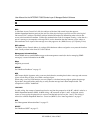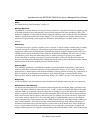
User Manual for the NETGEAR 7300S Series Layer 3 Managed Switch Software
C-18 Glossary
202-10088-01, March 2005
RSVP
See “Resource Reservation Setup Protocol” on page 17.
RTOS
See “Real-Time Operating System” on page 17.
S
Simple Network Management Protocol
SNMP is the protocol governing network management and the monitoring of network devices and their
functions. It is not necessarily limited to TCP/IP networks. The versions have the following differences:
SNMPv1 (full): Security is based on community strings.
SNMPsec (historic): Security is based on parties. Few, if any, vendors implemented this version of the
protocol, which is now largely forgotten.
SNMPv2p (historic): For this version, much work was done to update the SNMPv1 protocol and the SMIv1,
and not just security. The result was updated protocol operations, new protocol operations and data types,
and party-based security from SNMPsec.
SNMPv2c (experimental): This version of the protocol is called community string-based SNMPv2. It is an
update of the protocol operations and data types of SNMPv2p, and uses community-based security from
SNMPv1.
SNMPv2u (experimental): This version of the protocol uses the protocol operations and data types of
SNMPv2c and security based on users.
SNMPv2* (experimental): This version combined the best features of SNMPv2p and SNMPv2u. (It is also
called SNMPv2star.) The documents defining this version were never published as RFCs.
SNMPv3 (proposed): This version of the protocol is a combination of user-based security and the protocol
operations and data types from SNMPv2p and support for proxies. The security is based on that found in
SNMPv2u and SNMPv2*, and updated after much review. The documents defining this protocol will soon
be published as RFCs.
SimpleX signaling
SX is one of IEEE 802.3's designations for media. For example, 1000SX indicates 1000 gigabit Ethernet
over "short haul" or "short wavelength" optical fiber.
SMII
Serial Media Independent Interface.


















